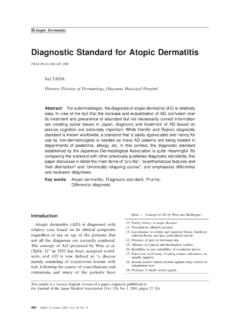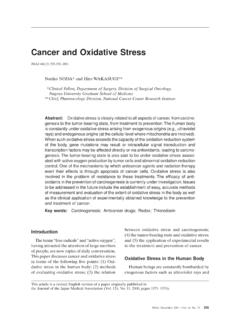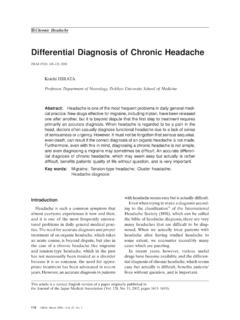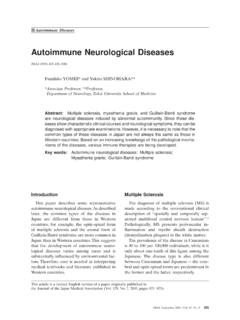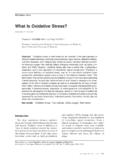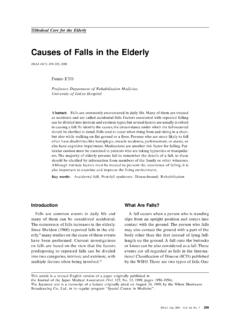Transcription of Understanding the Life Stages of Women to Enhance Your ...
1 273 JMAJ, September / October 2010 Vol. 53, No. 5 Research and ReviewsUnderstanding the Life Stages of Women toEnhance Your PracticeJMAJ 53(5): 273 278, 2010 Yuko TAKEDA*1 AbstractThe continuum of an individual s life can be divided into several life Stages , each characterized by certain by considerable hormonal changes, the life Stages of Women are generally divided into infancy,puberty, reproductive age, climacteric period, and elderly years, in addition to pregnancy and delivery that aregenerally included as the life events unique to Women . Health status in a particular stage then influences the nextstage. Japanese society has changed greatly over the past half century, and a woman s life at present is muchdifferent from what it was in the previous generation.
2 It is important to pay attention to the psychosocial aspectof Women s health and reflect such Understanding in clinical practice, incorporating a comprehensive view thatgoes beyond biomedical issues. For this purpose, it is necessary to understand the role of Women in the contextof sociocultural factors as well as the physical features characteristic of each age stage , and to examine thepatient s mental and social background. Knowledge of the more complex framework of life Stages deepensempathic Understanding and serves as a clue to the discovery of potential problems and unexpected supportive, Understanding attitude from a physician may lead to improved wellness of female wordsLife Stages , Wellness, Sociocultural expectations, Gender roles, Mental health*1 Professor, Department of Community-Oriented Medicine, Graduate School of Medicine, Mie University, Mie, Japan (as of August article is a revised English version of a paper originally published in the Journal of the Japan Medical Association ( , , 2009,pages 895 899).)
3 How Understanding Life stage HelpsYo uThe continuum of an individual s life can be dividedinto several life Stages with certain features charac-teristic of each stage . Developmental psychologyrecognizes themes characteristic to each stagethat change with For instance, one of thedevelopmental themes for the elderly include adaptation to declining status of physical strengthand health and adaptation to the death of one sspouse. Capturing the concepts of life Stages isuseful in Understanding the status and position ofother people. But, what does it mean for a clini-cian to understand the life Stages of Women ?
4 Biologically, life Stages of a typical woman aredivided into infancy, puberty (adolescence), sexualmaturation (reproductive age), climacteric period,and post-climacteric (elderly) years. Some stagesinclude fluctuations in the hormonal milieu aswell as the life events specific to Women , namelypregnancy and delivery (Fig. 1).1 Hormonesinteract with each other and control ovulatorycycles within the short-spanned temporal axis ofmenstrual cycles, and it is not unusual for suchhormonal changes to induce certain signs andsymptoms associated with are already well informed of medi-cal conditions that are common in Women andprovide differential diagnosis and treatment,always bearing in mind the gender difference inthe frequency and pattern of diseases.
5 In addi-tion, it is not unusual for clinicians to consider thelife Stages of each patient while following chronicdisease. Points of concern in clinical practicenaturally vary among female patients depending274 JMAJ, September / October 2010 Vol. 53, No. 5 Takeda Yon which Stages they are in ( , in puberty, atreproductive age and wishing to have a child, orthe elderly). General establishment of the term gender differences in medicine is facilitatingthe research in female subjects, including theaccumulation of clinical findings, development ofrelevant guidelines, and drug treatments basedon gender the other hand, to consider Women shealth issues from a wide point of view beyondbiomedical problems and psychosocial and socialaspects, it is necessary to obtain insight into thephysical characteristics of Women in each lifestage and their roles in the sociocultural contextin order to understand their mental and socialbackground.
6 Different health issues may arisefrom the livelihood of each stage , some manifestas physical symptoms. Because health status inone stage influences the next stage , havingknowledge of the framework of life Stages canbring deeper empathic Understanding in a clini-cian and lead to the discovery of potential prob-lems and/or solutions. For a physician whowishes to take care of female patients in accor-dance with their needs, an Understanding of theposition and role of Women at each life stagewould be helpful in daily practice and in provid-ing support to syndromeWork-life balanceCare for elderly parentsSexual harassment, sexual violenceEating disorderFull-timehousewifeSimultaneouspu rsuit of careerand familySchoolSmokingContraceptionIrregula r menstruation, amenorrheaPremenstrual syndromeDysmenorrheaSexually transmitted diseasePregnancy.
7 DeliveryInfertilityIrregular vaginal bleedingEndometriosisUterine myomaCervial cancerCorpus uteri cancerOvarian cancerBreast cancerEarly menopauseClimacteric disorderAbnormality of genitourinary organ(frequent urination, urinary incontinence,atrophic vaginitis)Decreased bone mass, osteoporosisHyperlipidemia, cerebrovascular diseaseLifestyle-related disease, periodontal diseaseSingle careerwomanEmploy-mentLow-calorie dietSomatoform disorder, somatization disorderAnxiety disorderMenarcheChildbearingMenopauseChi ld leavinghomeSolitary livingCare for spouseAcceptance of agingEmpty-nest syndrome10203040506070 Age(years)Level of female hormone secretionSexual maturation (Reproductive age)ClimactericperiodPost-climacteric (elderly) yearsPuberty(adolescence)Fig.
8 1 Life stage related mental health issues and diseases unique to women275 JMAJ, September / October 2010 Vol. 53, No. 5 Understanding THE LIFE Stages OF Women TO Enhance YOUR PRACTICEC hanges in the Life Stages of Womenin Japanese SocietyMajor changes have occurred in society duringthe past half-century, and Women s lives havechanged greatly compared to the previous gen-eration. Longevity has increased in both malesand females. The popularity of higher educationand changes in the concepts of marriage havegiven rise to increasing numbers of people notmarrying or marrying later in life, often causingdelays in events in life On the otherhand, the onset of puberty and the timing of firstsexual intercourse are occurring at increasinglylower ages.
9 Along with the declining birthrate,the trend away from multigenerational house-hold has caused changes in the role of family. Thedivorce rate is on the rise, but it is still difficultfor Women who have been full-time housewivesto find jobs with good employment , many households with single femaleparents often suffer from poor economic recent socioeconomic situation, which hasbeen characterized by stagnant wage growth, cor-porate downsizing, and increasing numbers oftemporary or part-time workers, has fosteredpositive views towards employing Women . How-ever, the number of Women with temporaryjobs has increased rapidly, and there remains alarge gap in earned income between male andfemale employees.
10 The idea of fixed genderroles remains tenaciously in Japan, placing theburden of household duties and child-rearingtasks more heavily on Women . In the area ofin-home caregiving for elderly parents, 80% ofthe cases are reported to be done by females. Ingeneral, Women spend large portions of theirlives caring for others, first aging parents andsubsequently Japan, the Equal Employment OpportunityAct was enacted in 1985 and amended in 1997,and along with the Basic Law for a Gender-equalSociety that was enacted in 1999. A basic frame-work for gender equality was prepared in Japanesesociety.

